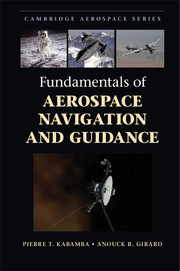Book contents
- Frontmatter
- Dedication
- Contents
- Preface
- 1 Introduction
- 2 Deterministic Systems Theory
- 3 Stochastic Systems Theory
- 4 Navigation
- 5 Homing Guidance
- 6 Ballistic Guidance
- 7 Midcourse Guidance
- 8 Optimization
- 9 Optimal Guidance
- 10 Introduction to Differential Games
- Epilogue
- APPENDIX A Useful Definitions and Mathematical Results
- Bibliography
- Index
1 - Introduction
Published online by Cambridge University Press: 05 October 2014
- Frontmatter
- Dedication
- Contents
- Preface
- 1 Introduction
- 2 Deterministic Systems Theory
- 3 Stochastic Systems Theory
- 4 Navigation
- 5 Homing Guidance
- 6 Ballistic Guidance
- 7 Midcourse Guidance
- 8 Optimization
- 9 Optimal Guidance
- 10 Introduction to Differential Games
- Epilogue
- APPENDIX A Useful Definitions and Mathematical Results
- Bibliography
- Index
Summary
Purpose and Motivation
The purpose of this book is to present fundamentals used in the navigation and guidance of aerospace vehicles. By fundamentals, we mean a body of knowledge that does not change with advances in technology. Aerospace vehicles encompass all kinds of craft flying in the atmosphere or in space. Navigation is concerned with the questions: Where is the vehicle? What is its velocity? And what are its angular orientation and angular rates? Guidance is concerned with the question: What maneuvers should we perform to cause the vehicle to go where we want, while meeting the specifications of the mission?
For centuries, devices such as charts, magnetic compasses, drafting compasses, sextants, and clocks were sufficient to solve the navigation and guidance problems of the time. In those days, velocities over land and sea were relatively slow, navigators could count on a variety of visible references (such as landmarks, beacons, or stars), and a human pilot controlled the vehicle during the entirety of the trip. However, the advent of air and space travel has posed substantial new challenges to navigators. First, aerospace vehicles generally travel much faster and farther than their land and sea counterparts. Second, whereas navigation on land and sea can be based on visible references, an aerospace navigator may be deprived of such resources. Finally, many aerospace missions require a high level of automation, either because they are unmanned or to minimize crew fatigue.
- Type
- Chapter
- Information
- Fundamentals of Aerospace Navigation and Guidance , pp. 1 - 13Publisher: Cambridge University PressPrint publication year: 2014

